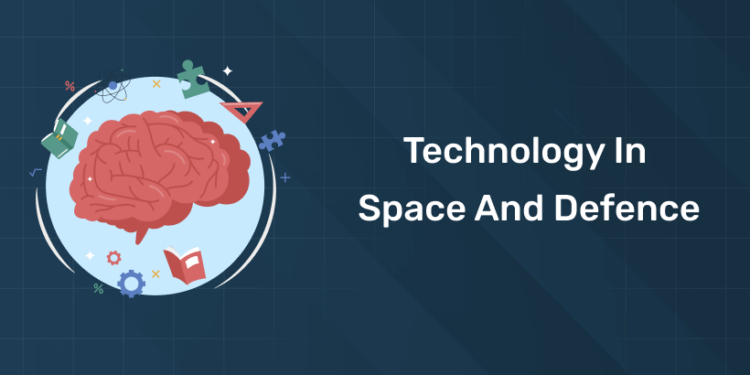Table of Contents
Technology is essential to the development of space exploration and defence, as well as to innovation, national security, and the advancement of humankind. We’ll examine the significance of technology in the space and defence industries in this blog, unearth interesting trivia, and offer an interactive test in PDF format to help you learn more about these important subjects.
Technology is vital to the future of civilization, from expanding the frontiers of space exploration to safeguarding national security on Earth. We’ll explore the importance of technology in the space and defence industries in this blog, unearth interesting trivia, and offer a knowledge-testing interactive quiz in PDF format. Come along with us as we set out to investigate the cutting edge of innovation and discovery in space and defence technology.
Importance of Technology in Space Exploration:
Humanity’s desire to travel beyond Earth to explore the cosmos and solve its mysteries is fueled by technology. By utilising technology, we are able to push the limits of what is feasible in space travel and open the door for further discoveries and advances in our comprehension of the cosmos.
Advancing Scientific Knowledge:
Technology enables us to build sophisticated spacecraft, probes, and telescopes that can study distant planets, stars, and galaxies. These tools provide valuable data and insights into the origins of the universe, the formation of celestial bodies, and the search for extraterrestrial life.
Enabling Human Spaceflight:
We can construct complex spacecraft, probes, and telescopes with the use of technology to investigate far-off planets, stars, and galaxies. These resources offer important information and perspectives on the formation of celestial bodies, the beginnings of the cosmos, and the hunt for extraterrestrial life.
Facilitating Robotic Exploration:
Innovative sensors, cameras, and equipment on robotic probes and rovers enable them to explore far-off regions of our solar system and beyond. By gathering information, gathering samples, and carrying out tests, these unmanned explorers contribute to our growing knowledge of planetary geology, atmospheres, and possible ecosystems
Pushing the Boundaries of Exploration:
The creation of next-generation spacecraft, propulsion systems, and habitats that allow humans to travel deeper and farther into space is driven by technological developments. Technology facilitates human exploration by opening up new vistas for space travel, such as the Moon, Mars, and grandiose ambitions for interstellar travel.
Inspiring Innovation and Collaboration:
Innovation is fueled by the difficulties of space travel in a variety of domains, including materials science, robotics, and propulsion. When handling complicated space missions, collaboration between government agencies, commercial firms, and foreign partners generates creativity, shared resources, and collective expertise.
Importance of Technology in Defence:
1: Who was the first woman President of India?
Enhancing Military Capabilities:
Modern equipment, vehicles, and weaponry are provided to armed forces by advanced technology, which improves their operational capacity and efficacy. Technology gives military forces a tactical edge in a variety of ways, from cyberwarfare instruments and precision-guided weapons to unmanned aerial vehicles (UAVs) and stealth aircraft.
Strengthening National Security:
Technology makes it possible to keep an eye out for, identify, and stop possible risks to national security, such as cyberattacks, terrorism, and hostile acts by enemies. Early warning systems, intelligence collecting platforms, and surveillance systems all assist in identifying and reducing security threats before they become more serious.
Promoting Strategic Deterrence:
Nuclear weapons, ballistic missile defence systems, and submarine-launched missiles are examples of advanced defence technology that act as a deterrent against possible enemies, avoiding the escalation of conflicts and maintaining peace through strength.
Supporting Peacekeeping and Humanitarian Efforts:
Operations including humanitarian relief, disaster response, and peacekeeping all benefit greatly from military technology. Military personnel can aid in times of crisis and humanitarian situations thanks to their rapid deployment capabilities, airlift and logistics support, and medical evacuation capabilities.
Fostering Innovation and Industrial Growth:
Investments in defence technology foster creativity, R&D, and innovation in vital sectors such as electronics, materials science, and aerospace. Technology breakthroughs are fueled by defence contracts and collaborations with commercial businesses, which promote economic expansion and employment development.
Addressing Emerging Threats:
Technological progress at a rapid pace has given rise to new security issues, such as space-based threats, asymmetric warfare techniques, and cyberwarfare. Keeping a competitive edge in a security environment that is constantly changing requires investing in state-of-the-art defence technology and capabilities.
Free UPSKILLING Courses!
Take your first step toward mastering in-demand skills, acing interviews, and securing top-tier jobs with Entri's free upskilling courses.
Start Learning!Fascinating Facts about Space and Defence Technology:
- Space-based GPS: Originally designed for military usage, the Global Positioning System (GPS) is now extensively utilised for non-military uses like mapping, timing synchronisation, and navigation. It is made up of a group of satellites that orbit the planet and provide precise location data to users all around the world.
- International Space Station (ISS): Several nations, including the US, Russia, Europe, Japan, and Canada, work together to construct the ISS. It promotes global collaboration in space exploration by acting as a living quarters and research facility for astronauts from all around the world.
- Stealth technology lowers an object’s radar signature, making it harder for adversary radar systems to detect military vehicles and aircraft. This technology reduces radar reflection and improves battlefield survival by using specific materials, forms, and coatings.
- Satellite Surveillance: Military forces can monitor and surveil areas of interest from orbit thanks to satellites that are outfitted with high-resolution cameras and sensors. For military operations and strategic planning, satellite imagery offers invaluable intelligence, reconnaissance, and surveillance capabilities.
- Cyberwarfare: Cyberwarfare is the use of hacking and computer-based attacks to take down or interfere with an enemy’s infrastructure, systems, and networks. In the digital age, cyberweapons such as viruses, spyware, and denial-of-service assaults represent a serious threat to national security.
- Ballistic Missile Defence: Systems for stopping incoming ballistic missiles before they reach their targets are known as ballistic missile defence systems. These systems identify and neutralise ballistic missile threats using space-based sensors, sea-based missiles, and ground-based interceptors.
- Space Tourism: Space tourism is becoming a reality thanks to developments in commercial spaceflight and space technology. SpaceX, Blue Origin, and Virgin Galactic are just a few of the companies creating spacecraft and launch technologies that will enable regular people to fly to the edge of space through civilian space travel.
History of Space and Technology
The Soviet Union, technically known as the “Union of Soviet Socialist Republics” (USSR), was the first nation on Earth to launch any kind of technology into space. October 4, 1957, saw the launch of the Sputnik 1 satellite by the USSR. Weighing around 83 kg (183 lb), it is thought to have completed one orbit around the earth. While temperature and pressure data was stored in the duration of radio beeps, information about the electron density of the ionosphere was obtained by analysis of the radio signals.
Yuri Gagarin, a 27-year-old Soviet cosmonaut, was carried on Vostok 1, the first successful human spaceflight, in April 1961. Either ground control or automated systems managed the mission as a whole. This occurred because the decision to lock the pilot’s manual controls was made because medical personnel and spacecraft engineers were unsure of how a human may react to weightlessness.
Technology in Space and Defence Quiz PDF
Free UPSKILLING Courses!
Take your first step toward mastering in-demand skills, acing interviews, and securing top-tier jobs with Entri's free upskilling courses.
Start Learning!Technology in Space and Defence Quiz:
We’ve developed an interactive quiz covering a variety of space and defence technology topics in PDF format to test your knowledge. This quiz will test your knowledge on anything from satellite technology and spacecraft systems to military advancements and historical landmarks, encouraging more research and investigation.
Q. What is the purpose of the Global Positioning System (GPS)?
a) Weather forecasting
b) Satellite communication
c) Navigation and positioning
d) Space exploration
Answer: c) Navigation and positioning
Q. Which international collaboration operates the International Space Station (ISS)?
a) NASA
b) European Space Agency (ESA)
c) United Nations (UN)
d) Roscosmos
Answer: d) Roscosmos
Q. What is the primary advantage of stealth technology used in military aircraft?
a) Increased speed
b) Enhanced maneuverability
c) Reduced radar signature
d) Higher payload capacity
Answer: c) Reduced radar signature
Q. Which type of satellite technology is commonly used for military surveillance and reconnaissance?
a) Geostationary satellites
b) Polar orbiting satellites
c) Weather satellites
d) Communication satellites
Answer: b) Polar orbiting satellites
Q. What is cyber warfare?
a) Warfare conducted in outer space
b) Military operations involving drones
c) The use of computer-based attacks
d) Biological warfare using viruses
Answer: c) The use of computer-based attacks
Q. Which defense system is designed to intercept and destroy incoming ballistic missiles?
a) Anti-aircraft guns
b) Ballistic missile defense
c) Submarine warfare
d) Electronic warfare
Answer: b) Ballistic missile defense
Q. What are Unmanned Aerial Vehicles (UAVs) commonly known as?
a) Rockets
b) Drones
c) Satellites
d) Aircraft carriers
Answer: b) Drones
Q. What is the primary advantage of directed energy weapons?
a) High cost-effectiveness
b) Unlimited range
c) Precision
d) Low energy consumption
Answer: c) Precision targeting
Q. Which emerging technology has the potential to revolutionize cryptography and data processing?
a) Artificial intelligence
b) Quantum computing
c) Virtual reality
d) Augmented reality
Answer: b) Quantum computing
Q. What is the primary goal of space tourism?
a) Conducting scientific research
b) Commercializing space resources
c) Expanding human presence in space
d) Offering civilian space travel experiences
Free UPSKILLING Courses!
Take your first step toward mastering in-demand skills, acing interviews, and securing top-tier jobs with Entri's free upskilling courses.
Start Learning!Frequently Asked Questions
What are the basics of space technology?
Why is space important to Defence?
Space is necessary for the operation of comprehensive systems, including traffic management and communications.Since a large portion of our forces rely on space-based navigation, intelligence, and communications, the military ramifications of losing access to space would be severe.
How is space technology used in Defence?
In order to conduct military operations ranging from conventional combat, asymmetric threats, disaster response, and out-of-area contingency operations, space offers the potential to connect assets across land, air, and sea.











